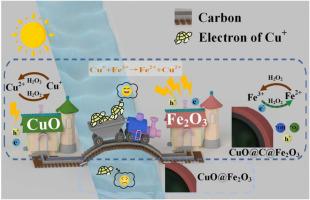当前位置:
X-MOL 学术
›
J. Alloys Compd.
›
论文详情
Our official English website, www.x-mol.net, welcomes your feedback! (Note: you will need to create a separate account there.)
Key role of carbon as an efficient electron bridge in CuO@C@Fe2O3 for enhancing H2O2 activation during photo-assisted Fenton-like reaction
Journal of Alloys and Compounds ( IF 6.2 ) Pub Date : 2024-04-06 , DOI: 10.1016/j.jallcom.2024.174385 Yubo Wu , Honglin Lin , Xuyun Gao , Zhiyan Liu , Yulun Nie
Journal of Alloys and Compounds ( IF 6.2 ) Pub Date : 2024-04-06 , DOI: 10.1016/j.jallcom.2024.174385 Yubo Wu , Honglin Lin , Xuyun Gao , Zhiyan Liu , Yulun Nie

|
The Fe/Fe cycle has been identified as the rate-limiting step in the Fenton system, and many efforts have been made to promote the Fe reduction via external electrons provided by various electron donors. However, how to design an efficient electron transport pathway and then inhibit the invalid electron shuttle has been largely underestimated. In this study, two kinds of heterogeneous Fenton catalysts of CuO@FeO and CuO@C@FeO were prepared. The key role of carbon in transporting electrons as an electron bridge and its enhancement mechanism in photo-assisted Fenton-like performances were explored in detail. Compared with CuO@FeO, the removal efficiency of tetracycline (TC) and the corresponding pseudo-first order reaction rate constants over CuO@C@FeO increased significantly from 88.6 % and 0.1054 min to 99.7 % and 0.2058 min, respectively. Based on a series of probe experiments, visible light irradiation can promote the reduction of Cu to Cu, then the carbon in CuO@C@FeO can effectively transfer electrons from Cu to Fe, enhancing the Fe/Fe cycle and the following Fenton-like efficiency. Since more ·OH while less ∙O was produced over CuO@C@FeO, which further supports the fact that the enhanced Fe/Fe cycle was due to the transfer electron from Cu to Fe instead of the Haber-Wiss mechanism. Hence, this study provides new insight for effectively improving the transfer efficiency and effective utilization of electrons in Fenton systems.
中文翻译:

碳作为 CuO@C@Fe2O3 中有效电子桥的关键作用,在光辅助芬顿反应过程中增强 H2O2 活化
Fe/Fe循环已被确定为芬顿系统中的限速步骤,并且已经做出了许多努力来通过各种电子供体提供的外部电子来促进Fe还原。然而,如何设计有效的电子传输路径,然后抑制无效的电子穿梭,却被很大程度上低估了。本研究制备了CuO@FeO和CuO@C@FeO两种非均相芬顿催化剂。详细探讨了碳作为电子桥在传输电子方面的关键作用及其在光辅助类芬顿性能中的增强机制。与CuO@FeO相比,CuO@C@FeO对四环素(TC)的去除效率和相应的准一级反应速率常数分别从88.6%和0.1054min显着提高到99.7%和0.2058min。基于一系列探针实验,可见光照射可以促进Cu还原为Cu,然后CuO@C@FeO中的碳可以有效地将电子从Cu转移到Fe,增强Fe/Fe循环以及随后的芬顿反应效率。由于CuO@C@FeO上产生了更多的·OH,而更少的·O,这进一步支持了这样一个事实,即增强的Fe/Fe循环是由于电子从Cu转移到Fe而不是Haber-Wiss机制。因此,本研究为有效提高芬顿系统中电子的传输效率和有效利用提供了新的见解。
更新日期:2024-04-06
中文翻译:

碳作为 CuO@C@Fe2O3 中有效电子桥的关键作用,在光辅助芬顿反应过程中增强 H2O2 活化
Fe/Fe循环已被确定为芬顿系统中的限速步骤,并且已经做出了许多努力来通过各种电子供体提供的外部电子来促进Fe还原。然而,如何设计有效的电子传输路径,然后抑制无效的电子穿梭,却被很大程度上低估了。本研究制备了CuO@FeO和CuO@C@FeO两种非均相芬顿催化剂。详细探讨了碳作为电子桥在传输电子方面的关键作用及其在光辅助类芬顿性能中的增强机制。与CuO@FeO相比,CuO@C@FeO对四环素(TC)的去除效率和相应的准一级反应速率常数分别从88.6%和0.1054min显着提高到99.7%和0.2058min。基于一系列探针实验,可见光照射可以促进Cu还原为Cu,然后CuO@C@FeO中的碳可以有效地将电子从Cu转移到Fe,增强Fe/Fe循环以及随后的芬顿反应效率。由于CuO@C@FeO上产生了更多的·OH,而更少的·O,这进一步支持了这样一个事实,即增强的Fe/Fe循环是由于电子从Cu转移到Fe而不是Haber-Wiss机制。因此,本研究为有效提高芬顿系统中电子的传输效率和有效利用提供了新的见解。



























 京公网安备 11010802027423号
京公网安备 11010802027423号